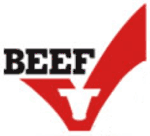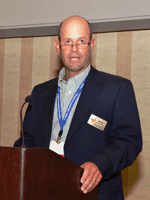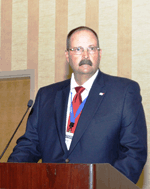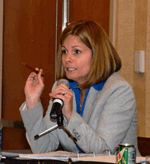
A newly approved structure for joint beef checkoff committees endeavors to engage more cattle producers and beef importers who pay the checkoff in a more efficient decision-making process about investment of their hard-earned checkoff investments. Adopted unanimously by both the Cattlemen's Beef Board (CBB) and the Federation of State Beef Councils during the recent 2012 Cattle Industry Summer Conference in Denver, the new structure effectively reduces the number of checkoff program committees which are responsible for making recommendations to the Beef Promotion Operating Committee about programs to fund with checkoff dollars from the current 13 to just four in 2013. Each of those four new committees will be tied directly to core strategies identified in the 2011-2013 Beef Industry Long Range Plan with subcommittees for the domestic market formed around the beef demand drivers identified in that same plan. As envisioned, committees will be flexible enough to change with adoption of a new long range plan, if those strategies and demand drivers change.
 "Unification of the industry around the goals of the Long Range Plan is the vision of the plan itself," said Beef Board member Hank Maxey, who chaired the CBB Special Committee on Committee Structure, appointed by the Beef Board to examine the checkoff committee structure and determine if it was still the best fit for today's checkoff. The resulting proposal approved at summer conference was the work of that committee, with input from and coordination with producer leaders of the Federation of State Beef Councils. "This joint working group reviewed the draft structure presented to the Boards in February, and also reviewed many other committee models, to find the model that would best fit today's checkoff work," said Federation Chairman Craig Uden of Nebraska. Results of that work was presented both to the full Cattlemen's Beef Board and, separately, to the directors of the Federation, during the 2012 summer conference, and both boards approved the new structure unanimously. According to the approved structure, the four initial checkoff program committees will be:
"Unification of the industry around the goals of the Long Range Plan is the vision of the plan itself," said Beef Board member Hank Maxey, who chaired the CBB Special Committee on Committee Structure, appointed by the Beef Board to examine the checkoff committee structure and determine if it was still the best fit for today's checkoff. The resulting proposal approved at summer conference was the work of that committee, with input from and coordination with producer leaders of the Federation of State Beef Councils. "This joint working group reviewed the draft structure presented to the Boards in February, and also reviewed many other committee models, to find the model that would best fit today's checkoff work," said Federation Chairman Craig Uden of Nebraska. Results of that work was presented both to the full Cattlemen's Beef Board and, separately, to the directors of the Federation, during the 2012 summer conference, and both boards approved the new structure unanimously. According to the approved structure, the four initial checkoff program committees will be: Domestic Consumer Preference Committee
Global Growth Committee
Beef's Image Committee
Freedom to Operate Committee
"If you review the Long Range Plan, you'll find these four core strategies right up front," Maxey said. "There are, in total, six core strategies to the Long Range Plan, but these four are the ones the working group said were appropriate for checkoff funding." From the outset, the Domestic Consumer Preference Committee will have five subcommittees, each focused on one of five consumer demand drivers in the Long Range Plan: convenience; safety; value; nutrition and health; and taste. Other committees may appoint subcommittees where deemed necessary by committee members. "You'll note that the goal is to improve domestic preference for beef not demand," Maxey pointed out. "Of course, beef demand involves volume and price. The Long Range Plan committee knew that we have more direct control over improvement of consumer preference, but not so much control over improvement in beef demand, due to our inability to control price." Addressing other strategies/committees, Maxey pointed out the continued growth in opportunities for beef in global markets; the industry's need to focus on proactive ways to strengthen its image in the consumer environment, especially in light of increased attacks on beef and beef products in anti-meat arenas; and the need for the checkoff to help protect the consumer environment, thereby protecting beef producers' future and freedoms.
 Approval of the new structure came just months after the Beef Board and Federation adopted a new Joint Committee Agreement, at the 2012 Cattle Industry Convention in Nashville in February, which removed all policy members from any committees with checkoff representation and adjusted the way members are appointed to committees. At that time, both boards asked special subcommittees to review the committee structure and report back to them at the summer conference. Maxey and Uden spoke to a joint gathering of the members of the Beef Board and directors of the Federation during the summer conference to explain the process the special committees went through to form their proposed structure, and explained that structure to them. "As a kickoff point to our discussion, we agreed upon five critical success factors for an optimal committee structure," Uden explained. "We asked ourselves, if we had the best committee structure, what would that structure achieve?" In brief, those five factors said the joint checkoff committees should:
Approval of the new structure came just months after the Beef Board and Federation adopted a new Joint Committee Agreement, at the 2012 Cattle Industry Convention in Nashville in February, which removed all policy members from any committees with checkoff representation and adjusted the way members are appointed to committees. At that time, both boards asked special subcommittees to review the committee structure and report back to them at the summer conference. Maxey and Uden spoke to a joint gathering of the members of the Beef Board and directors of the Federation during the summer conference to explain the process the special committees went through to form their proposed structure, and explained that structure to them. "As a kickoff point to our discussion, we agreed upon five critical success factors for an optimal committee structure," Uden explained. "We asked ourselves, if we had the best committee structure, what would that structure achieve?" In brief, those five factors said the joint checkoff committees should: 1. Strategically align to the Beef Industry Long Range Plan and research-based beef demand drivers
2. Be flexible enough to change with industry needs
3. Beef efficient in the decision-making process and provide valuable input to program staff and the Operating Committee to which the committees make recommendations for checkoff funding
4. Increase awareness about the Beef Checkoff Program among a greater number of producers and importers
5. Engage committee members and provide them a greater sense of ownership in their beef checkoff.
"The new committee structure is a really big step forward to focusing checkoff work on consumer demand and preference," Beef Board CEO Polly Ruhland said. "Of course, most of the work of the checkoff goes into the domestic consumer preference area in other words, getting American consumers to love beef more than they already do," Ruhland continued. "So that committee does have five subcommittees, and those subcommittees revolve around consumer demand drivers identified in the Long Range Plan."

Ruhland explained that converting to the new structure will take place between now and the next cattle industry annual convention, slated for February 2013 in Tampa, Fla. In the fall, she said, CBB and Federation officers, separately, will appoint their members to the new committees. Then, based on the joint agreement the boards approved in winter, the chairman and vice chairman of the Operating Committee (the CBB chairman and the Federation chairman) will appoint chairs and vice chairs to each of the committees. Ruhland said she is pleased with the level of involvement and engagement of Beef Board members in the process to make committee decisions more strategic and more consumer-focused. "The Beef Board's unanimous vote in favor of the new committee structure came after about 40 minutes of very good discussion about it," she said. "Our Board members are very interested in doing the right thing. They take their responsibility very seriously, so there were a lot of questions about committee size, function, how existing checkoff programs fit into the new structure. They asked great questions because they wanted to be very educated and clear about what they were doing in approving this new structure to leverage every checkoff dollar to the greatest extent possible." For a copy of the Special Committee on Committee Structure's progress report to the full Beef Board, visit Special Committee Report, and for a visual presentation of the new structure, visit Committee Matrix.
08.13.2012